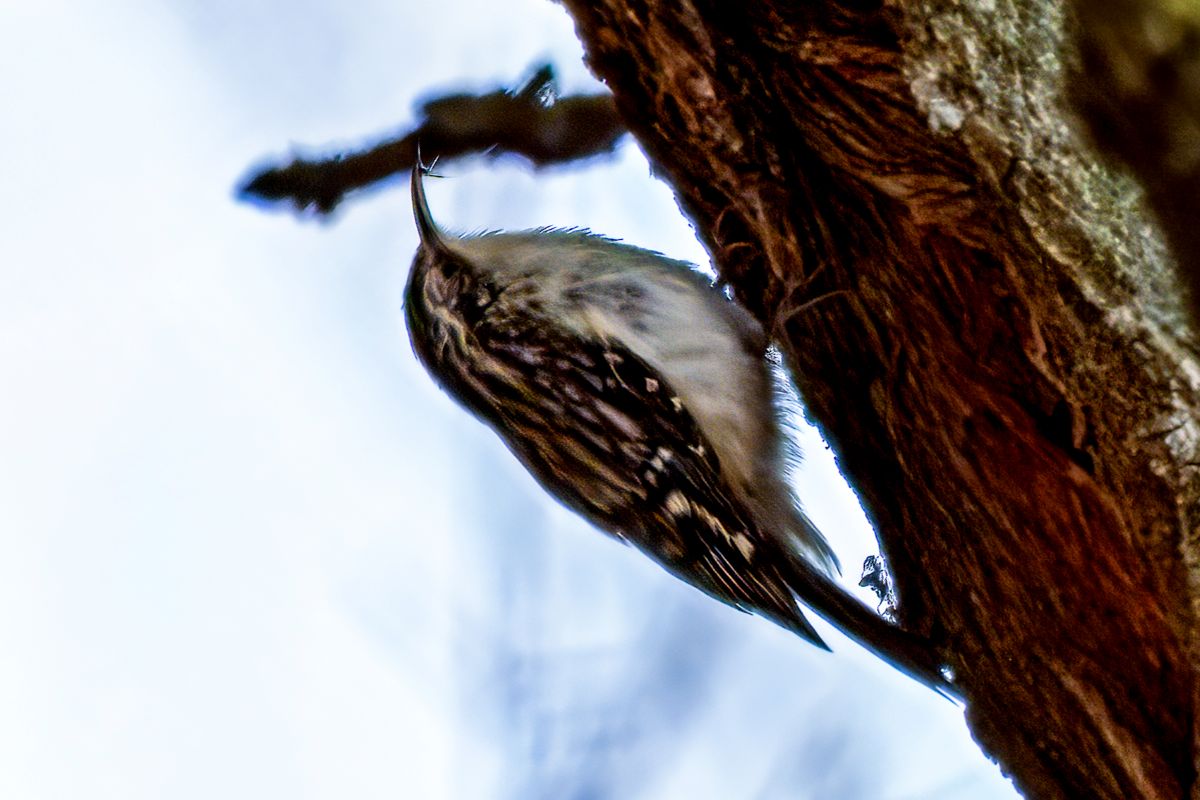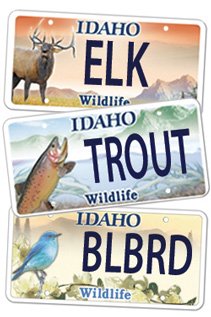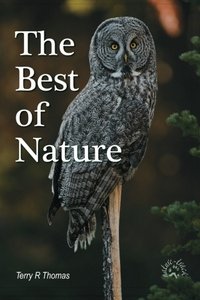Brown Creeper

This brown creeper has caught a spider for part of its meal.
We were down near Hagerman, Idaho, last week enjoying a snow-free break and adding to our bird count. Near Clear Lakes Resort we pulled into a small park owned and maintained by Idaho Power and began listening for birds with the Merlin app. Cathy surprised me when she said that Merlin identified a yellow-rumped warbler. I would have thought it was still too early for warblers, even in the acknowledged Banana Belt of Idaho. I began to look more closely and suddenly detected movement on a tree trunk. When I found the spot in my binoculars, I was rewarded with not a yellow-rumped warbler, but rather, a brown creeper and I reached for the camera.
Brown creepers are common birds, but they are hard to see! They are tiny, well camouflaged—Audubon says, “like a piece of bark come to life,” and in nearly constant motion spiraling or zigzagging up tree trunks. We commonly hear them (well, Merlin does) outside our bedroom window, but we rarely see one. Then there is getting a photo of one that is decent enough to accompany this column, and you will see why I have deferred writing about this species for so long.
The brown creeper is about five inches long, about the size of a red-breasted nuthatch. It has a white chest and belly, but the back and sides are a mix of brown, tan and white that indeed does make them look like a living piece of bark. There is a whitish stripe above the eye and the rump is rust-colored. The bill is long, very thin, and curved downward and the tail feathers are stiff and pointy like those of a woodpecker which, also like a woodpecker, it uses to brace itself against the tree.
All of this, the behavior of moving up and down tree trunks, the camouflage, small size, and a long thin bill indicate that this bird is a specialist predator, not in species of prey, but rather, in size and location of prey. As it moves up the tree trunks, it is hunting visually as well as probing deeply with that pointy bill into bark fissures looking for any small bit of protein from insect eggs, to spiders, small insects, and anything else larger birds are likely to miss.
The brown creeper is one of the more common birds in North America, ranging from Florida to Alaska and Mexico to southern Canada as a year-round resident in most places. It is a forest bird, preferring older coniferous forest trees, the bigger the better. In the eastern US, brown creeper numbers have declined, likely because of extensive logging. Second growth is not habitat until it is mature.
Brown creepers build their hammock-type nests behind loose pieces of bark on dead or dying trees, a unique strategy not discovered until 1879. The nest is mostly built by the female with the male supplying some of the nesting material. Once the nest is completed, the female lays five to six half-inch-long eggs and less than 40 days later, the chicks have left the nest.
A brown creeper put its camouflage to good use when chased by a predator. It will flatten itself against the bark of a tree with wings extended, becoming nearly invisible.
My photos turned out to be less than extraordinary, to say the least. However, they are good enough to illustrate what the tiny brown creeper looks like so you can be aware and on the lookout for this wonderful bird.
Help Idaho Wildlife
When we traveled across the state in October 2017, we visited most of the Idaho Department of Fish and Game wildlife management areas. Most of the vehicles we saw using the wildlife management areas did not have wildlife plates. Buying wildlife plates is a great way for non-hunters and hunters alike to support wildlife-based recreation like birding.
C'mon folks, let's help Idaho's wildlife by proudly buying and displaying a wildlife license plate on each of our vehicles!
See below for information on Idaho plates. Most states have wildlife plates so if you live outside Idaho, check with your state's wildlife department or vehicle licensing division for availability of state wildlife plates where you live.
And tell them that you heard about it from Nature-track.com!

Wildlife License Plates
Great news! as of 2024, there are three NEW designs for license plates. They still are bluebird, cutthroat trout and elk, but they are beautiful.
Idaho Wildlife license plates provide essential funding that benefits the great diversity of native plants and wildlife that are not hunted, fished or trapped—over 10,000 species or 98% of Idaho’s species diversity. Game species that share the same habitats (such as elk, deer, antelope, sage-grouse, salmon, trout) also benefit from these specialty plates.
No state tax dollars are provided for wildlife diversity, conservation education and recreation programs. Neither are any revenues from the sale of hunting or fishing licenses spent on nongame species. Instead, these species depend on direct donations, federal grants, fundraising initiatives—and the Idaho Wildlife license plates.
Both my vehicles have Bluebird Plates. I prefer the bluebird because the nongame program gets 70 percent of the money from bluebird plates, but only 60 percent of the money from elk and trout plates - 10 percent of the money from elk plates supports wildlife disease monitoring and testing programs (to benefit the livestock industry) and 10 percent from cutthroat plates supports non-motorized boat access.
Incidentally, in 2014, the Idaho Legislature denied the Department of Fish and Game the ability to add new plates or even to change the name of the elk and cutthroat plates (very specific) to wildlife and fish plates, a move that would have allowed for changing images occasionally and generating more revenue. It would seem that they believe that we Idahoans don't want a well funded wildlife program.
I think it is time we let the Legislature know that Idahoan support wildlife funding and that we would like to see these generic plates come to fruition.

"WOW. What a phenomenal piece you wrote. You are amazing." Jennifer Jackson
That is embarrassing, but actually a fairly typical response to my nature essays. Since The Best of Nature is created from the very best of 16 years of these nature essays published weekly in the Idaho Falls Post Register (online readership 70,000), it is a fine read. It covers a wide variety of topics including humorous glimpses of nature, philosophy, natural history, and conservation. Readers praise the style, breadth of subject matter and my ability to communicate complex and emotional topics in a relaxed and understandable manner.
Everyone can find something to love in this book. From teenagers to octogenarians, from the coffee shop to the school room, these nature essays are widely read and enjoyed.
Some of the essays here are my personal favorites, others seemed to strike a chord with readers. Most have an important message or lesson that will resonate with you. They are written with a goal to simultaneously entertain and educate about the wonderful workings of nature. Some will make you laugh out loud and others will bring a tear to the eye and warm your heart.
Readers Write:
"You hit a home run with your article on, Big Questions in Nature. It should be required reading for everyone who has lost touch with nature...great job!" Joe Chapman
"We enjoyed your column, Bloom Where Planted. Some of the best writing yet. The Post Register is fortunate to have your weekly columns." Lou Griffin.
To read more and to order a copy, click here or get the Kindle version
Copies are also available at:
Post Register
Island Park Builders Supply (upstairs)
Barnes and Noble in Idaho Falls
Harriman State Park, Island Park
Museum of Idaho
Valley Books, Jackson Wyoming
Avocet Corner Bookstore, Bear River National Wildlife Refuge, Brigham City, Utah
Craters of the Moon National Monument Bookstore, Arco, Idaho